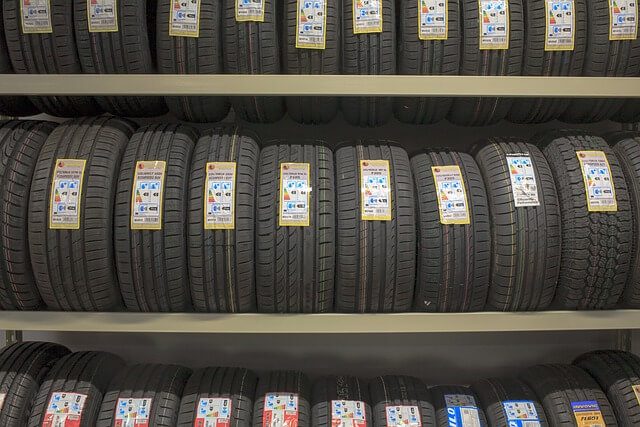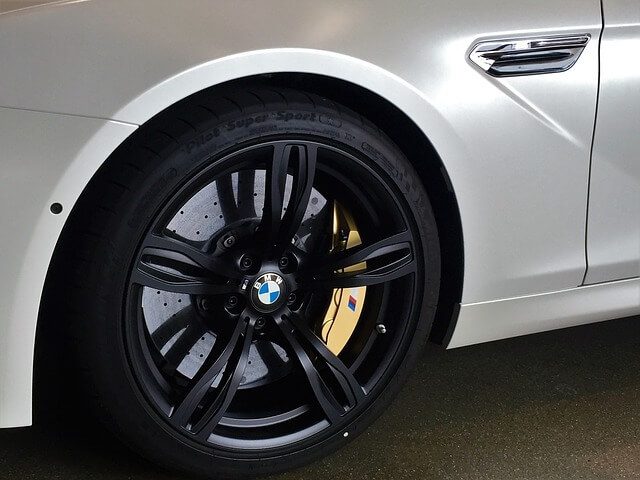
Pros and cons of leasing a car
13 February 2024Knowing the correct tyre sizes is essential for proper vehicle maintenance. Tyres are more than just circular rubber parts; they are complex engineering components crafted to enhance performance and safety.
Whether you're a seasoned motorist or a novice, decoding tyre sizing in the UK can be overwhelming and confusing for lots of drivers. But fear not! Signature to the rescue! In this guide, we will cover everything you need to know and hopefully demystify this essential aspect of vehicle maintenance.
In this article
ShowHide- Understanding Tyre Size Markings
- How to find correct Tyre size For Your Vehicle
- Importance of Correct Tyre Sizes
- Factors to Consider When Choosing Tyres
- Common Tyre Size Conversions
- Plus Sizing Tyres: Advantages and Disadvantages
- Impact of Tyre Sizes on Vehicle Handling
- Common Mistakes to Avoid When Choosing Tyres
- Benefits of Using Correct Tyre Sizes
- Conclusion - Tyre Sizing
- FAQs - Tyre Size
Understanding Tyre Size Markings
Tyres play a vital role in the driving experience. However, they can be quite perplexing. Labels, sizes, and technology have all evolved significantly throughout the years of using cars. As a result, understanding tyre sizes can be quite confusing for us drivers. Tyre sizing is all about the dimensions of the tyres on your car and the speed limit they can handle.
So whilst tyre size markings may look like a jumble of numbers and letters, they actually convey important information about the tyre's dimensions and specifications. The standard format for tyre size markings in the UK follows a pattern like this: 205/55 R16 91V.
How to Read Tyre Size Charts
Tyre size charts typically display information in a specific format, indicating various aspects such as width, aspect ratio, rim diameter, load index, and speed rating. Once you grasp how to decipher these charts, you'll be able to easily find suitable tyre sizes for your vehicle.
Here's a breakdown of how to interpret tyre size charts in the UK:-
- The first number in the tyre size (205) represents the tyre's width in millimetres.
- The second number (55) indicates the aspect ratio, which is the height of the sidewall expressed as a percentage of the width.
- The letter (R) signifies the construction type, with "R" denoting radial construction. Most modern tyres are radial tyres, so 'R' is commonly found in tyre sizes.
- The following number (16) indicates the diameter of the wheel rim in inches.
- The final characters (91V) represent the load index and speed rating respectively.
- The load index indicates the maximum load-carrying capacity of the tyre. A higher number indicates a higher load capacity. The load index can be found in a separate chart corresponding to specific numerical values.
- The speed rating indicates the maximum speed at which the tyre can carry a load under specific conditions. It is represented by a letter and can also be found in a separate chart. Common speed ratings include 'H' (up to 130 mph), 'V' (up to 149 mph), and 'W' (up to 168 mph).
How to find correct Tyre size For Your Vehicle
Refer to your car's manual
The initial step is to consult the manual of your vehicle. It typically includes details regarding the suggested tyre dimensions for your particular vehicle.
Check out the current tyres
If you need to replace old tyres, you can locate the tyre size printed on the sidewall of your current tyres. The information will consist of a combination of numbers and letters, like "205/55 R16". These values represent the tyre's width, aspect ratio, and rim diameter.
Utilise online tools
Numerous online calculators exist for determining the appropriate tyre size. Input your car's make, model, and year to receive the recommended sizes.
Consider visiting a tyre shop
Visit a tyre shop for expert guidance and assistance in determining the right tyre size for your vehicle. They are able to provide recommendations on the most suitable tyre for your driving requirements and budget.

Importance of Correct Tyre Sizes
It is crucial to use the correct tyre sizes for various reasons. First, it guarantees the best handling and performance of your vehicle. When tyres are not of the correct sizing, they can impact acceleration, braking, and cornering abilities, which can jeopardise safety while driving.
Moreover, using the wrong tyre size may cause higher fuel consumption and uneven tyre wear, leading to increased maintenance expenses over time.
Therefore, understanding how tyre size markings function will help you confidently handle this important aspect of car maintenance.
Factors to Consider When Choosing Tyres
If you're looking to purchase replacement tyres, buying a used car and verifying it has the right wheels and tyres, or planning to adjust your car's wheels for winter or improved handling, knowing about tyre sizes is crucial for staying compliant and safe. Therefore, when choosing tyres, it's important to consider various factors.
Vehicle Compatibility
Each vehicle model comes with specific tyre size recommendations tailored to its weight, dimensions, and performance capabilities. So ensure that the tyres you choose are suitable for your vehicle's specific make and model. Refer to your vehicle's manual or consult a tyre specialist to find the correct size for your vehicle.
Driving Conditions
Think about the usual driving situations you come across. For instance, if you often drive in wet or icy conditions, you might require tyres with improved traction and grip.
Performance
Various tyre sizes may impact how your vehicle performs. Choosing smaller tyres could lead to improved fuel efficiency, whereas opting for larger tyres may improve handling and stability.
Common Tyre Size Conversions
It's crucial to grasp tyre size conversions, particularly when looking for new tyres or upgrades. Typical conversions involve transitioning from metric to imperial measurements or moving up to larger wheels.
Plus Sizing Tyres: Advantages and Disadvantages
Upgrading to larger diameter wheels with lower profile tyres is a popular choice for enhancing both the look and performance of a vehicle. Using a larger tyre size can improve your vehicle's performance in terms of handling and cornering, but it might lead to a less comfortable ride and make your car more vulnerable to damage from potholes.
Impact of Tyre Sizes on Vehicle Handling
Understanding the sizes of tyres is crucial in influencing how a vehicle performs on the road. Bigger tyres enhance traction and stability, particularly during high-speed manoeuvres, while smaller tyres can offer a more comfortable ride at the expense of performance.
Common Mistakes to Avoid When Choosing Tyres
Make sure to consider load-carrying capacity, speed rating requirements, and compatibility with your vehicle's suspension setup when selecting tyre sizes to avoid common mistakes.
Benefits of Using Correct Tyre Sizes
Opting for the right tyre size provides a range of advantages such as increased safety, improved fuel efficiency, better performance, and longer tyre lifespan. Choosing the appropriate tyres for your vehicle can enhance your driving experience by providing a smoother and safer ride.
Conclusion - Tyre Sizing
It's crucial to grasp tyre sizing to keep your vehicle running smoothly and safely. Understanding tyre size markings, taking important factors into account, and steering clear of typical errors will help you select the perfect tyres for top-notch performance on the road.
FAQs - Tyre Size
What is the significance of the numbers on tyre sidewalls?
Tyre sidewall numbers show dimensions like width, aspect ratio, and diameter, as well as load and speed ratings.
Is it possible to use different tyre sizes on my vehicle?
It is advisable to adhere to the tyre size recommended by the manufacturer for the best performance, fuel efficiency and safety.
How frequently should I inspect my tyre sizes?
Regular tyre inspections, including monitoring tyre size and condition, should be conducted as part of routine vehicle maintenance. In addition, make sure to inspect your tyre size whenever you're changing tyres or if you observe any handling or performance problems.
What happens if you use the wrong tyre sizes?
Using the wrong tyre size can have a detrimental effect on how your vehicle handles, its fuel efficiency, tyre lifespan, and safety.
Does plus sizing work for all vehicles?
Increasing the size of your tyres may not be ideal for every vehicle, potentially impacting the smoothness of your ride and necessitating changes to suspension parts.
Are there specific tyre sizes for different seasons?
Yes, manufacturers offer seasonal tyres tailored to varying weather conditions. Summer tyres optimise performance in warm conditions, while winter tyres enhance traction on snow and ice-covered roads.
Get in touch for professional car body repairs
We hope you enjoyed reading our article about tyre size and found it useful. If you're looking for professional car body repairs, then bring your vehicle to our car body shop in Radcliffe near Manchester and our professional technicians will take care of it for you.
In addition, for your convenience, we offer a fully mobile service and can come to you. We cover the whole of Greater Manchester, Lancashire, Cheshire, Merseyside and Yorkshire.
If you’d like to get a price for our professional car body repairs service, then please get in touch with us now on 0161 667 0919 or by filling out our quick quote form to get a free, no-obligation quotation.
We have lots of 5 star reviews on Google from happy customers, so please feel free to check out our reviews.
Or contact our team to arrange a time to bring your vehicle in for an estimate. We look forward to restoring your vehicle and getting you back on the roads!



